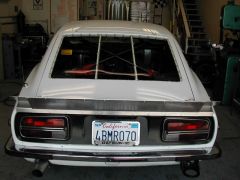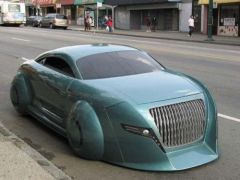-
Posts
9842 -
Joined
-
Last visited
-
Days Won
56
Content Type
Profiles
Forums
Blogs
Events
Gallery
Downloads
Store
Everything posted by johnc
-
IMHO, putting a prop valve in the cockpit of a car isn't a good idea unless is a race car driven by someone who knows how to brake. I've seen a few drivers immediately back off on rear brake when they get a little rear lockup in one corner. Lap times dropped a bit because braking was affected on all subsequent corners where rear lockup wasn't a problem. Its an even dumber idea in a street driven car where I've had customer cars come in with the rear brakes turned down as far as the prop valve adjuster allows. When asked, the owner said, "Well, it was raining about 6 months ago and I turned the rear brakes down because I was afraid they would lock up. I guess I forgot to turn them back up." Again, that's just my opinion.
-
No, most likely FelPro.
-
These guys are good and they have a showroom trailer they take to tracks: http://www.winecountrymotorsports.com/
-
If you run a good damper (like an ATI unit) that's custom spec'd for the crank you can lighten away.
-
My head size is 7 1/2 and is kind long and narrow (think the creature in Alien). Bells and Shoei's seem to fit my freaky head just fine. I currently have a Bell M3 and a Shoe RF1100. I've also had the Bell Vortex and it fit very well.
-
Mine was knife edged and lightened to 35 lbs. That was 17 lbs. lighter then stock. And the Japanese do not use the SAE grading system for steel.
-
I don't think its a mixture issue. It sounds like the timing is retarded or cam is too advanced. Typically the L series is a bit doggy under 4000 and then starts coming alive above that. Your distributor advance should take it to 36 at 3000 to 3500.
-
Engine builder says this was caused by a lean mixture. There are no other signs of detonation or leanness so I was wondering if anyone else has seen something like this? Engine was rebuilt and then broken in on the street for 100 miles before 40 laps on a race track. Head gasket let go at the end of the day. Thanks for the help.
-
Don't expect any changes in the model year exemption from smog testing.
-
Perfect!
-
I wish I could charge $1,900 for an L6 exhaust! Maybe in stainless... One of the issues with high end hot rod and race shops is that they get a certain hourly rate for a lot more complicated work then an exhaust. They want to maintain that rate for all their work and thus exhaust work gets pretty expensive if that's the only work being done on a car. If they are already doing tens of thousands of dollars of work on a car, then a custom exhaust becomes cheaper and is sometimes thrown in for material costs only.
-
Guys, this is Keith's for sale ad. Create your own for sale ad if you're selling something.
-
This 240Z TIG welded exhaust including the custom Y pipe, Borla muffler, hardware, and installation was $1,300 at my shop. Mild steel .049" wall 3". Took 9 hours to build and install (including header install). That was 5 years ago and the car is still winning races with VARA. Some info: 25 tube junctions that needed to be measured, marked, cut, squared, and deburred after each cut. 25 welds that needed to be butted together (square) and fixed in place for tacking. 25 TIG welds at 9.42" per weld = 19.63 feet of total weld - NO drop through or MIG whiskers in the exhaust. At least three complete assembly/installs to check fit before final assembly. Anti-seize on all the fasteners and the slip joints so the come a part again quickly at the race track. Stainless (304) T-Bolt clamps for the slip connections. Good flange gaskets (not the crap from Pep Boys) and new bolts, washers, and metal lock nuts. New hangers that are mounted in the correct place on the chassis with new bolts, washers, and metal lock nuts. New muffler clamps (only used for mounting to the hangers) that actually fit a 3" tube and don't damage or crush it. That's the attention to detail you get for the money.
-
Your horizontal/harness bars appear very low. I've never built a S30 cage with the harness bars that low. They are typically at the 25 degree bend where the main hoop legs go vertical. I don't see how you're going to meet the restraint installation rules with the harness bars in that position: Yeah.... looking at it some more, you won't pass tech with those horizontal braces/harness bars. Even if you run the shoulder harnesses back the STB the horizontal braces still don't neet the rules. I suggest you cut them out and move them up to shoulder level behind the seat.
-
If the stepped clamps worked for 10 years, why change? A bolted slip joint like in the pictures above is more expensive to build and is designed for frequent assembly/disassemble. For even faster servicing on race cars I used collector springs and tabs:
-
Most muffler shop style slip joints are too loose to seal unless the pipes are distorted by the old style muffler clamps. SPD, Burns, and others make tight slip joints (called Transitions) that are held in place by a T-Bolt clamp, bolt tabs, or collector springs and self seal when the exhaust tubing heats up. They can be a bitch to get a part of anti-sieve isn't used during assembly. The inlet side of this merge collector shows a typical transition slip fit These Stahl headers show a bolt tab slip fit. Below is a turbo header I amde showing a bolted slip fit connection:
-
I don't know enough to answer that. My unintelligent guess is that, unless you're running some plumbing to direct the oil from the main squirter toward the piston, you'll most likely be spraying oil mostly on the connecting rod due t the angle involved:
-
There is such a thing as too much oil on the cylinder walls and the pistons. The oil rings can only do so much and oil foaming can be a problem at high rpms. If your engine is build with additional clearance on the rod bearings, oil squirters are normally closed off to prevent too much oil on the cylinder walls. The throw off from the rod bearings is more then enough. If the rod bearing clearances are built to tighter/OEM/street tolerances then the oil squirters help with cylinder wall lubrication. With a race prepped oil pump and oiling system there's normally plenty of pressure and volume to handle oil squirters, spray bars, larger bearing clearances, etc.
-
You mean the instructional videos might be wrong? The horror! There's no way a propane torch can heat up an aluminum intake manifold to 700 degrees. As mentioned above, aluminum quickly sucks the heat away from the point of application and transfers it throughout the base material. It does this faster then a propane torch can add heat. You have to get the whole part to 700 degrees. Try putting it in your over for 30 minutes at 500 degrees. Then pull it out and quickly use your torch. That will give you a fighting chance.
-

s30 Fiberglass tilt front clip i've googled for hrs...
johnc replied to vega's topic in Body Kits & Paint
I'm guessing you'll be better making a mold from your steel front end.





















